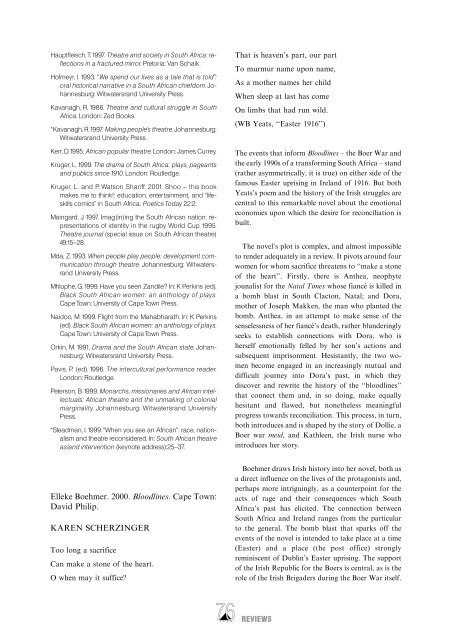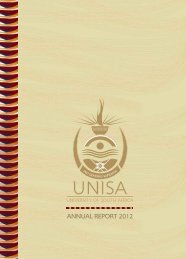Editor Co-editor Associate Editors Editorial Board - University of ...
Editor Co-editor Associate Editors Editorial Board - University of ...
Editor Co-editor Associate Editors Editorial Board - University of ...
You also want an ePaper? Increase the reach of your titles
YUMPU automatically turns print PDFs into web optimized ePapers that Google loves.
Hauptfleisch,T.1997. Theatre and society in South Africa: reflections<br />
in a fractured mirror.Pretoria:VanSchaik.<br />
H<strong>of</strong>meyr, I.1993. ``We spend our lives as a tale that is told'':<br />
oral historical narrative in a South African chiefdom. Johannesburg:<br />
Witwatersrand <strong>University</strong> Press.<br />
Kavanagh, R. 1986. Theatre and cultural struggle in South<br />
Africa. London: Zed Books.<br />
*Kavanagh, R.1997. Making people's theatre. Johannesburg:<br />
Witwatersrand <strong>University</strong> Press.<br />
Kerr, D.1995. African popular theatre.London: James Currey.<br />
Kruger, L.1999. The drama <strong>of</strong> South Africa: plays, pageants<br />
and publics since 1910. London: Routledge.<br />
Kruger, L. and P. Watson Shariff. 2001. Shoo ^ this book<br />
makes me to think!: education, entertainment, and ``lifeskills<br />
comics'' in South Africa. PoeticsToday 22:2.<br />
Maingard, J. 1997. Imag(in)ing the South African nation: representations<br />
<strong>of</strong> identity in the rugby World Cup, 1995.<br />
Theatre journal (special issue on South African theatre)<br />
49:15^28.<br />
Mda, Z.1993.When people play people: development communication<br />
through theatre. Johannesburg: Witwatersrand<br />
<strong>University</strong> Press.<br />
Mhlophe, G.1999. Have you seen Zandile? In: K Perkins (ed).<br />
Black South African women: an anthology <strong>of</strong> plays.<br />
CapeTown: <strong>University</strong> <strong>of</strong> CapeTown Press.<br />
Naidoo, M. 1999. Flight from the Mahabharath. In: K Perkins<br />
(ed). Black South African women: an anthology <strong>of</strong> plays.<br />
CapeTown: <strong>University</strong> <strong>of</strong> CapeTown Press.<br />
Orkin, M. 1991. Drama and the South African state. Johannesburg:<br />
Witwatersrand <strong>University</strong> Press.<br />
Pavis, P. (ed).1996. The intercultural performance reader.<br />
London: Routledge.<br />
Peterson, B.1999. Monarchs, missionaries and African intellectuals:<br />
African theatre and the unmaking <strong>of</strong> colonial<br />
marginality. Johannesburg: Witwatersrand <strong>University</strong><br />
Press.<br />
*Steadman, I.1999.``When you see an African'': race, nationalism<br />
and theatre reconsidered. In: South African theatre<br />
as/and intervention (keynote address):25^37.<br />
That is heaven's part, our part<br />
To murmur name upon name,<br />
As a mother names her child<br />
When sleep at last has come<br />
On limbs that had run wild.<br />
(WB Yeats, ``Easter 1916'')<br />
The events that inform Bloodlines ± the Boer War and<br />
the early 1990s <strong>of</strong> a transforming South Africa ± stand<br />
(rather asymmetrically, it is true) on either side <strong>of</strong> the<br />
famous Easter uprising in Ireland <strong>of</strong> 1916. But both<br />
Yeats's poem and the history <strong>of</strong> the Irish struggles are<br />
central to this remarkable novel about the emotional<br />
economies upon which the desire for reconciliation is<br />
built.<br />
The novel's plot is complex, and almost impossible<br />
to render adequately in a review. It pivots around four<br />
women for whom sacrifice threatens to ``make a stone<br />
<strong>of</strong> the heart''. Firstly, there is Anthea, neophyte<br />
jounalist for the Natal Times whose fiance is killed in<br />
a bomb blast in South Clacton, Natal; and Dora,<br />
mother <strong>of</strong> Joseph Makken, the man who planted the<br />
bomb. Anthea, in an attempt to make sense <strong>of</strong> the<br />
senselessness <strong>of</strong> her fiance 's death, rather blunderingly<br />
seeks to establish connections with Dora, who is<br />
herself emotionally felled by her son's actions and<br />
subsequent imprisonment. Hesistantly, the two women<br />
become engaged in an increasingly mutual and<br />
difficult journey into Dora's past, in which they<br />
discover and rewrite the history <strong>of</strong> the ``bloodlines''<br />
that connect them and, in so doing, make equally<br />
hesitant and flawed, but nonetheless meaningful<br />
progress towards reconciliation. This process, in turn,<br />
both introduces and is shaped by the story <strong>of</strong> Dollie, a<br />
Boer war meid, and Kathleen, the Irish nurse who<br />
introduces her story.<br />
Elleke Boehmer. 2000. Bloodlines. Cape Town:<br />
David Philip.<br />
KAREN SCHERZINGER<br />
Too long a sacrifice<br />
Can make a stone <strong>of</strong> the heart.<br />
O when may it suffice?<br />
Boehmer draws Irish history into her novel, both as<br />
a direct influence on the lives <strong>of</strong> the protagonists and,<br />
perhaps more intriguingly, as a counterpoint for the<br />
acts <strong>of</strong> rage and their consequences which South<br />
Africa's past has elicited. The connection between<br />
South Africa and Ireland ranges from the particular<br />
to the general. The bomb blast that sparks <strong>of</strong>f the<br />
events <strong>of</strong> the novel is intended to take place at a time<br />
(Easter) and a place (the post <strong>of</strong>fice) strongly<br />
reminiscent <strong>of</strong> Dublin's Easter uprising. The support<br />
<strong>of</strong> the Irish Republic for the Boers is central, as is the<br />
role <strong>of</strong> the Irish Brigaders during the Boer War itself.<br />
~76 .... REVIEWS
















